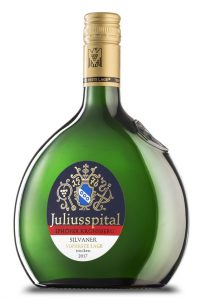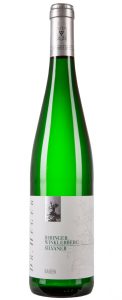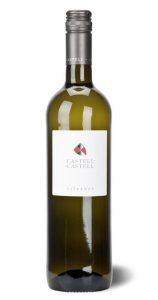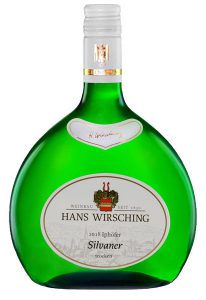Every month, our 5 to Try series showcases five examples of stellar wines from varying wine styles, grapes, and Germany’s 13 winegrowing regions. This month, the spotlight’s on Silvaner!
While we can’t travel internationally and explore other countries’ cultures the way we would like to, the wine world offers a silver lining with countless varieties and centuries of history to discover – especially in Germany.
Silvaner is one variety that’s made its home in Germany, which accounts for over 70% of the world’s Silvaner plantings. A natural crossing of Traminer and Österreichisch Weiss (literally “Austrian white”), the grape thrives in Franken and Rheinhessen in particular. Franken Silvaner is famous for the traditional bottle called Bocksbeutel, sporting a unique short and flat shape.
On the nose, you’ll find floral and herbal aromas as well as notes of melon and apple. On the palate, Silvaner is juicy and mouth-filling, with mild acidity and delicate earthy and fruity tones. Full-bodied yet neutral, it’s an ideal pairing with food, especially seafood and classically hard-to-pair vegetables like asparagus.
So grab a Bocksbeutel and raise a glass of Silvaner to new tasting opportunities!
1. Juliusspital Iphöfer Kronsberg Silvaner Trocken Erste Lage, Franken

Juliusspital is not only a wine estate but a charitable foundation and an impressive testament to Germany’s winemaking history.
In 1576, Prince Bishop Julius Echter von Mespelbrunn of Würzburg donated his personal property – including vineyards – to fund the Juliusspital Foundation. To this day, Juliusspital cares for the sick and elderly through its hospital center, retirement home, counseling center, an academy for palliative medicine/care and hospice work, and teaching facilities for nursing, geriatric care, and intensive care. The foundation also manages a convention center, a large agricultural enterprise, and extensive forests – and, of course, the wine estate with its 172 hectares of vines, making it the second largest wine estate in Germany.
The winery has been a part of the Foundation from the very beginning, sharing space in the Princes’ Building in Würzburg and contributing profits to fulfilling its social responsibilities.
2. Dr. Heger Ihringer Winklerberg Silvaner Erste Lage, Baden
 Coincidentally, our second wine comes from an estate with roots in medicine as well. Based in Ihringen am Kaiserstuhl in the Baden region, Weingut Dr. Heger was established in 1935 by Dr. Max Heger, a physician in Ihringen, who spent his free time as an amateur winemaker. His patients were primarily local wine industry workers, and they inspired Max’s growing passion for wine.
Coincidentally, our second wine comes from an estate with roots in medicine as well. Based in Ihringen am Kaiserstuhl in the Baden region, Weingut Dr. Heger was established in 1935 by Dr. Max Heger, a physician in Ihringen, who spent his free time as an amateur winemaker. His patients were primarily local wine industry workers, and they inspired Max’s growing passion for wine.
Over time he began to acquire vineyards on the fine Achkarrer Schlossberg and Ihringer Winklerberg sites, which would form the foundation for Dr. Heger’s rise into an internationally recognized estate. Today it is run by third generation Joachim Heger and his wife Silvia.
3. Castell ‘Castell-Castell’ Silvaner Trocken, Franken
 Fun Franken Fact: The oldest documentation of Silvaner in Germany details the purchase of Silvaner vines by a Castell estate administrator on April 5, 1659. They were planted at the foot of Castell’s Schossberg hill in the Reitsteig vineyard the following day.
Fun Franken Fact: The oldest documentation of Silvaner in Germany details the purchase of Silvaner vines by a Castell estate administrator on April 5, 1659. They were planted at the foot of Castell’s Schossberg hill in the Reitsteig vineyard the following day.
The history of the Castell family can be traced back to the year 1057, and records of vineyards belonging to the Counts of Castell date back to 1224. With almost 800 years of winemaking tradition, the Castell domain is one of the oldest German wineries.
That’s a lot of history to drink in!
Find near you: Wine-Searcher.com
4. Hans Wirsching Iphöfer Silvaner Trocken, Franken
 Another from Franken (after all, the grape is historically linked to Franken, and the region today has the highest percentage of the country’s Silvaner plantings), the Hans Wirsching winery is located in the historic Iphofen village, with roots back to the 1630’s. In the early 1920’s, Hans Wirsching Sr. supposedly came up with the idea to name the village’s prime vineyard site of Iphöfer Julius-Echter-Berg after the prince bishop who founded Juliusspital.
Another from Franken (after all, the grape is historically linked to Franken, and the region today has the highest percentage of the country’s Silvaner plantings), the Hans Wirsching winery is located in the historic Iphofen village, with roots back to the 1630’s. In the early 1920’s, Hans Wirsching Sr. supposedly came up with the idea to name the village’s prime vineyard site of Iphöfer Julius-Echter-Berg after the prince bishop who founded Juliusspital.
The family tells another story that in 1980, Pope John Paul II visited Germany, and Heinrich Wirsching (son of Hans Sr.) presented him with a basket with 3 Bocksbeutel bottles of the estate’s 1967 Silvaner Feinste Auslese. During Mass, the Chalice was dropped, and one of the priests quickly replaced the wine with one of the gifted bottles. The Pope allegedly asked for the rest of the bottle and enjoyed it later that evening.
Today, Hans Wirsching is managed by the family’s 14th generation, Andrea Wirsching. Silvaner is their dominant grape planting, accounting for 38% of vineyard area.
Find near you: Wine-Searcher.com
5. Weinreich Silvaner, Rheinhessen

Last but not least, the Weinreich winery in Rheinhessen, which has a much more recent history but definitely a pioneer in their own right.
Marc Weinreich and his brother took over the family business in 2009 and immediately switched to organic farming, harvesting only by hand, fermenting on natural yeasts, and ultimately creating natural wines that clearly reflect their origins. These sustainable, minimal intervention tactics seem novel today, but are in fact much closer to the practices of winemakers from the past.
Interestingly enough, although Franken has the highest percentage of Silvaner plantings today, Rheinhessen has more acres planted to Silvaner and is the world’s largest growing area of Silvaner.
Don’t forget to tag and follow @GermanWineUSA!
